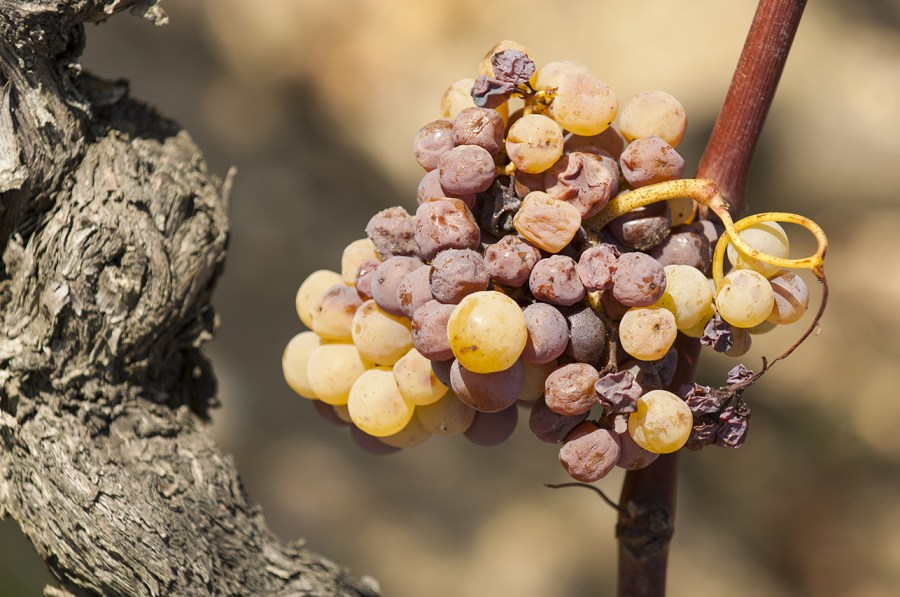Botrytis is an opportunistic pathogen that usually needs some sort of injury to act as an entry point for infection.
Wounds and natural fissures in ripening grapes during late summer are an obvious route, but perhaps less well understood is the infection that can occur around flowering and lay dormant within developing bunches until later in the year.
This latent infection usually expresses itself once conditions become conducive, but in some seasons, such as when conditions are warm and dry, latent infection may be present, but symptoms never actually show. Predicting that far ahead is impossible, so it is important to understand the risks and manage them accordingly.
Flowering infection
Flowering is the main period when latent infection occurs, primarily through Botrytis cinerea spores entering the scar tissue left when the flower cap (calyptra) detaches, exposing the male (stamen) and female (pistil) parts of the flower for pollination.
While the ovule then becomes infected, the pathogen cannot colonise surrounding green tissue due to the high concentration of anti-microbial chemicals (stilbenes). Infection therefore remains “hidden” in a latent state within the developing berry, effectively inactive without vines expressing any symptoms, until conditions favour the disease.
This usually occurs after veraison, when the vine’s natural defences start to decline, sugar content within ripening berries increases, and skins become thinner. Wet, warm conditions further increase the risks of latent disease finally expressing itself.
Risk factors
Botrytis spores are almost always present in vineyards, spreading in the air, by insect vectors and rain splash. The optimum temperature for spore germination is around 18-21°C, although research shows some can germinate below 10°C or above 30°C. Surface moisture is essential though, which can be provided by rain, dew, mist, fog, or even just very high humidity.
The risk of latent infection occurring is far greater when flowering is protracted, particularly in warm and wet conditions. Such situations may also result in infected flower parts becoming lodged within developing bunches, potentially posing another infection point as the season progresses.
Although plant pathologists can test for latent infection by using agar plates to grow any fungal spores present in prepared tissue samples, commercial testing to assess hidden risk is not yet available. Growers must therefore evaluate underlying risks and protect crops accordingly.
Protecting crops
There are several ways vines and developing bunches can be protected from latent infection.
Applying Botryticides at key points through the flowering window is an effective way of protecting the fresh calyptra scars when they are most susceptible, but as ever, product choice and timing is key.
Depending on the duration of flowering, a two-spray strategy is common, although three may be necessary if flowering is very protracted, so it is important to use a range of actives and modes of action for resistance management. The main options include pyrimethanil, fenhexamid, and cyprodinil + fludioxonil.
Pyrimethanil is generally best reserved for late flowering or early fruitlet timing, as it can move within the plant tissue and arrest any latent infection already established in the berry, resulting in measurable reductions in laccase levels in the juice – a key indicator of fungal infection.
Kresoxim-methyl and tebuconazole also offer a moderate amount of Botrytis activity control, but should generally only be used in low-risk situations.
Managing canopies to improve airflow and reduce the chances of creating a favourable microclimate for fungal development is key to managing diseases, including Botrytis, while bunch thinning also helps. Spatially separating bunches reduces the chances of infection spreading from one bunch to the other later in the season.
It is also important to minimise the risk of any other forms of damage that could act as potential portals for Botrytis infection. This includes scarring caused by thrips on the surface of embryonic berries, fissures associated with early powdery mildew infection, or physical damage to the surface of berries during de-leafing, for example.
Finally, don’t forget about the importance of optimising nutrition to improve vine health. In particular, ensuring good calcium supply can help reduce Botrytis prevalence by improving the robustness of cell walls and berry skins. While it is rare to find calcium deficiency in the leaf, availability can be lower when transpiration is reduced, such as in cold, or very dry, drought conditions.




